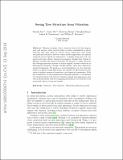Seeing Tree Structure from Vibration
Author(s)
Xue, Tianfan; Wu, Jiajun; Zhang, Zhoutong; Zhang, Chengkai; Tenenbaum, Joshua B; Freeman, William T; ... Show more Show less
DownloadAccepted version (8.413Mb)
Terms of use
Metadata
Show full item recordAbstract
Humans recognize object structure from both their appearance and motion; often, motion helps to resolve ambiguities in object structure that arise when we observe object appearance only. There are particular scenarios, however, where neither appearance nor spatial-temporal motion signals are informative: occluding twigs may look connected and have almost identical movements, though they belong to different, possibly disconnected branches. We propose to tackle this problem through spectrum analysis of motion signals, because vibrations of disconnected branches, though visually similar, often have distinctive natural frequencies. We propose a novel formulation of tree structure based on a physics-based link model, and validate its effectiveness by theoretical analysis, numerical simulation, and empirical experiments. With this formulation, we use nonparametric Bayesian inference to reconstruct tree structure from both spectral vibration signals and appearance cues. Our model performs well in recognizing hierarchical tree structure from real-world videos of trees and vessels.
Date issued
2018-10Department
Massachusetts Institute of Technology. Computer Science and Artificial Intelligence Laboratory; Massachusetts Institute of Technology. Department of Electrical Engineering and Computer ScienceJournal
European Conference on Computer Vision
Publisher
Springer International Publishing
Citation
Xue, Tianfan et al. "Seeing Tree Structure from Vibration." European Conference on Computer Vision, September 2018, Munich, Germany, Springer International Publishing, October 2018. © Springer Nature Switzerland AG 2018.
Version: Author's final manuscript
ISBN
9783030012397
9783030012403
ISSN
0302-9743
1611-3349